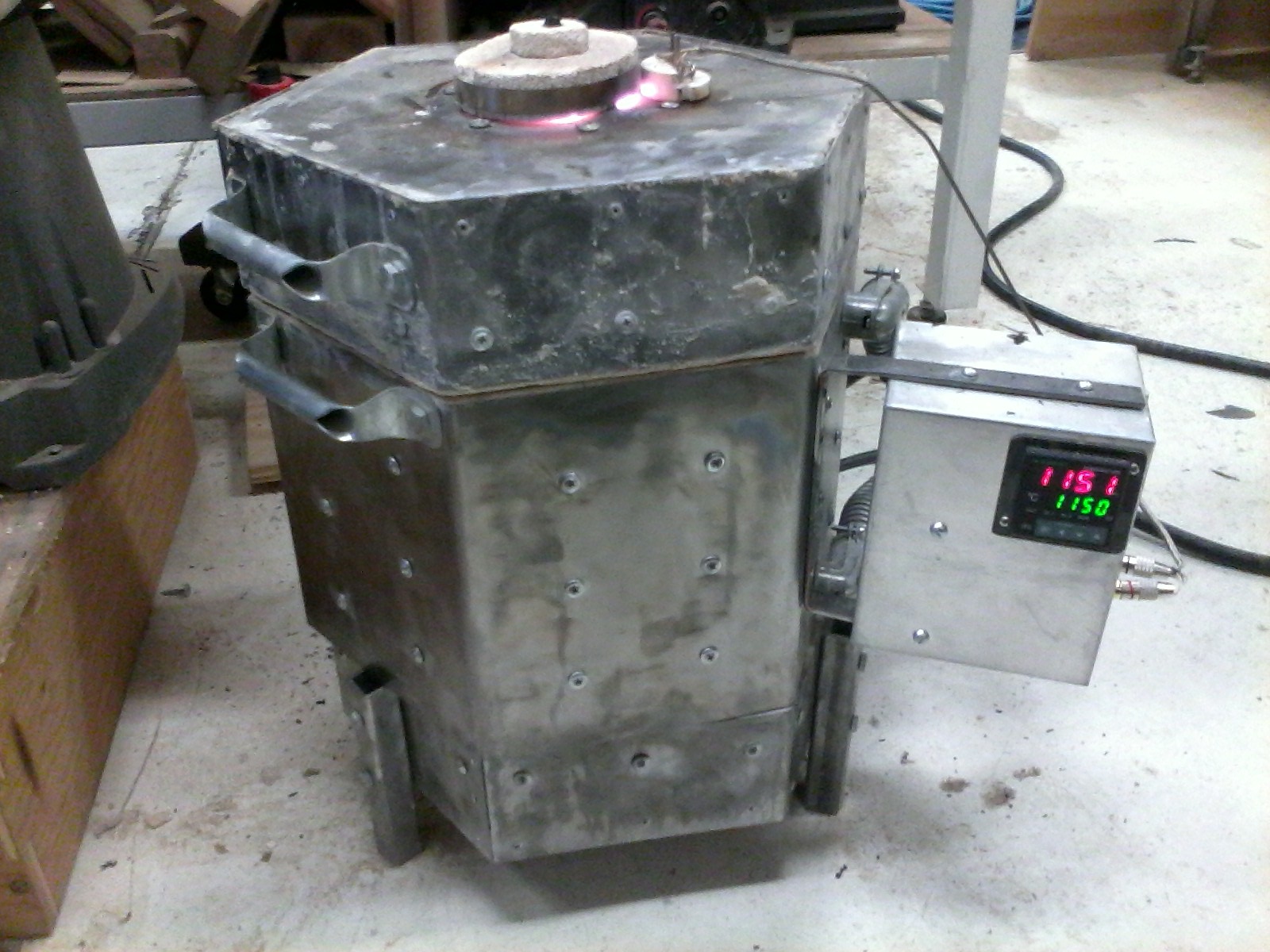I now have completed building my new metals melting furnace and have it at the Spokane Veterans' Garage.
The design of the furnace is based upon the "An Improved Electric Shop Furnace" by Dan Hartmann at
www.dansworkshop.com.
The new furnace is controlled with a PID computerized controller which allows me to control temperatures within 10 degrees.
My original castings were cast primarily bronze blanks using scrap metal
to make golf putter heads. Using a band saw, drill press, milling machine, heavy
sander and a bench grinder with a polishing wheel, I finish the heads.
The use of a golf club making jig to attach heads and grips to premade club shafts makes
completion of the clubs simple.
I am pleased with how it melts aluminum. The new furnace has some difficulty handling the higher temperatures and corrosive environment of melting brass.
Why Electricity instead of Natural Gas?
Gas is much cheaper than electricity per btu, but gas fire adds a great deal of
hydrogen porosity to aluminum when subjecting it to the fire. Gas fired furnaces also
need exhaust ports. This bleeds heat that can be used to melt metal. It just gets wasted into
the atmosphere. From my experience, degassing molten aluminum is much more difficult
than degassing molten copper alloys. A gas fire produces a great deal of hydrogen which gets
into the molten aluminum and causes the aluminum to form spongelike pours after it solidifies.
I expect the hydrogen perosity problem will be reduced while using electricity rather
than using gas. There are no products of combustion introduced to the furnace chamber with
electricity. If that does not solve the problem, I will build a special miniature
hydrogen degassing unit with the help of some of my fellow ASM buddies with aluminum
casting expertise. Anyway, the electric furnace will be much more compact than the gas
furnace. It will be simpler to disconnect, move and store when not in use.
Casting History
My manufacturing processes teacher just happened to have an old annealing furnace in his
back yard doing nothing. He sold it to me and we brought the furnace to Tom's house and
started experimenting. We managed to get gas lines to the furnace and attached a blower to
the air intake and get the furnace operational. We managed to get the fires so hot that the
refractory in the existing furnace fell apart.
We decided to build a higher capacity furnace on the existing stand. I designed a new
box and counter weighted door system which could handle higher temperatures and a much
larger crucible. I formed had four convergent-divergent fuel-air mixture nozzles for directing
the flame into the chamber using 3500 degree F refractory, two exhaust ports using the same
refractory, and made four inch walls made of 2500 F refractory given to me for free by A.P.
Green, since the material had passed its expiration date, but was still perfectly viable
material.
Stock Steel gave me the sheet metal to make the shell and Tom had the equipment
to bend and cut the metal so we could form a new box which to house the guts of the furnace.
Once the box was formed, we made forms for the walls, ceiling and floor of the furnace
interior. We attached dozens of Stainless Steel bolts through the box walls for refractory
reinforcement, put the forms and nozzles in place, poured the refractory into the compartments.
After a week of letting the refractory curing at ambient temperatures, we slowly introduced gas flames
into the furnace until we reach the right amount of time and temperature to cure the refractory
to handle the higher temperatures.
After that, melting brass was relatively easy. An owner of a local casting house was kind enough to tell me how to
degass copper alloys in a simple manner so I could make my castings with good clean brass and
bronze. We worked in the shop just about every weekend making one thing or another until Tom's
illness made it too difficult for doing two man jobs. The work with the furnace slowed to a crawl
then virtually stopped when I had to move to my job at Bay Shore Systems in Rathdrum.
I just got too busy getting drawings out to the production line in Rathdrum and spent too much
time on the road between Spokane and Rathdrum to keep up energy to safely operate the furnace
myself.
I am excited to know that I am back melting metals and am making new mold designs to make castings again.

